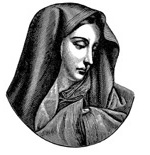
Marian Misconceptions
HER OWN HAVE RECEIVED HER NOT
Mary, the mother of Jesus, is far and away the world’s most influential woman, beloved not only by Catholics and Eastern Orthodox but also by Muslims. An entire chapter of the Koran is devoted to her, and even Protestants such as Martin Luther and John Calvin have sung her praises. Johann Sebastian Bach, a devout Lutheran, honored her with his Magnificat; Nathaniel Hawthorne prayed to her; Sir Walter Scott died with her name on his lips. The eminent nineteenth-century Harvard historian Henry Adams wrote that she “remains the most intensely…most widely and most personally felt of all characters, divine…human or imaginary, that ever existed among men. Nothing has ever remotely taken her place.” More recently, her crown of twelve stars (Rev. 12:1) has graced the flag of the European Union.
Through the lens of the secular observer, such recognition may appear remarkable. But what astonishes believers is the fact that the Blessed Mother fails to find room in the hearts of many who should, by rights, welcome her. Take, for example, those under the mistaken impression that Marian veneration is biblically unsound. Scripture tells us that the Blessed Virgin gave us our Lord on four separate occasions: first at Nazareth with her “yes” to Gabriel, then at Bethlehem with her delivery in a stable, again at Cana where she launched Him on His public mission, and finally at Calvary where she saw Him through His passion and death. When she pronounced her “yes” at Nazareth she became, in a very real sense, the spouse of the Third Person of the Blessed Trinity, since it was the Holy Spirit who overshadowed and impregnated her (Lk. 1:35).
If Holy Writ told us nothing more about the Blessed Mother, this alone would justify all the attention she has received. But there is more. Jesus, speaking from the cross, asked His beloved Apostle, John, to regard Mary as his spiritual mother, even though John’s biological mother, Salome, stood looking on at a distance (Mt. 27:56). By extension, this makes Mary, in John’s words, the mother of all “who keep the commandments of God and bear testimony to Jesus” (Rev. 12:17). That John portrays her as a queen (Rev. 12:1), as well as a mother, is still further reason to view Marian veneration as Bible-based.
Significantly, Jews at the time of Christ regarded their queen mother as second only to the king in importance. There is an Old Testament precedent for this. Bathsheba, who sat on a throne next to that of her son, Solomon, was viewed as an intercessor (1 Kgs. 2:18-20), and her position relative to the king became the norm for Jewish royals. Thus, when John portrays Mary as a queen wearing a crown of twelve stars, he is following tradition. If Christ is our King, as He Himself claimed before Pilate, then Mary is our queen.
You May Also Enjoy
A syllogism: (1) Whatever is not contained in Scripture is not to be believed; (2) Sola Scriptura is not contained in Scripture; (3) Sola Scriptura is not to be believed.
A remarkable amount of evidence supports the claim that Jesus was capable of performing deeds that could not be explained as natural phenomena.
The grace of marriage allows the parties to become one flesh and calls forth from them the same love Christ has for His Church.

